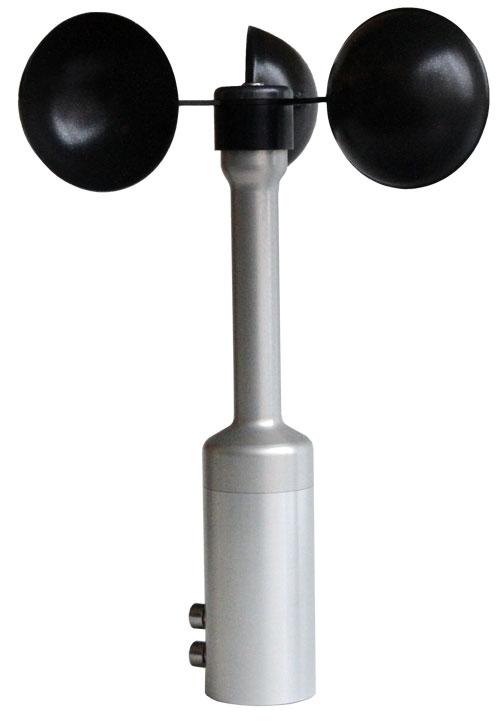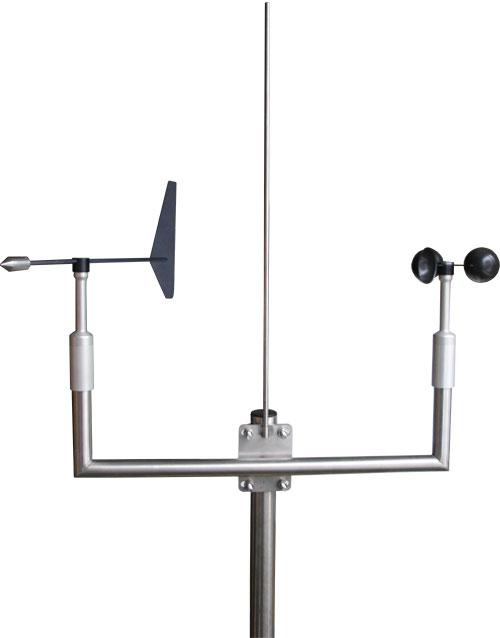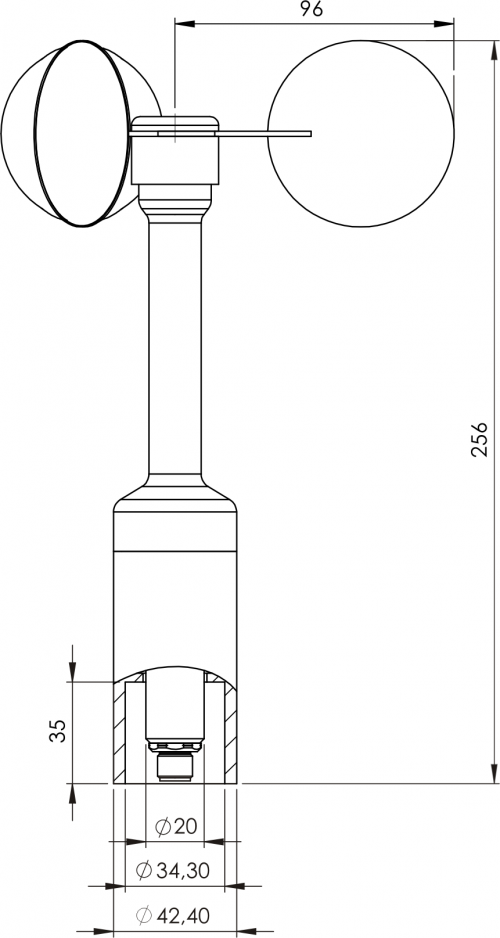WS103 - wind speed and gust sensor

Characteristics
- Robust all-metal design suitable for mountain environments
- Ceramic bearings for long-term operation without service interventions
- Wide measuring range 0.6 to 60 m / s
- Magnetic speed sensing and very low average current consumption <250 uA
- Continuous evaluation of the average wind speed and wind gusts even when the power supply is disconnected for up to 20 minutes (sensor suitable for battery-powered data loggers operating in the periodic sensor power supply mode)
- Communication via RS485 bus (Modbus RTU, FINET): average and instantaneous wind speed, maximum wind gust
- Optional secondary output 0 to 60 m/s:
- voltage 0-1 V DC
- frequency 0-600 Hz
- pulses 0-600 pulses / sec
- ALARM signal 0/1
- Connection via M12 industrial connector hidden in the sensor body
- The WS103-H anemometer has built-in controlled heating for year-round operation
- Data output compatible with FIEDLER data loggers and telemetry stations
Basic description
The electronic circuits of the anemometer evaluate every second the frequency and delay between the pulses induced by the rotating magnetic field above the sensitive sensor and on this basis continuously calculate:
- instantaneous wind speed
- average wind speed
- maximum wind gust
All these measured and calculated quantities can be transmitted to the connected recording or control unit via the RS485 serial bus under Modbus RTU protocol.
Immediate or average wind speed can also be output to the secondary frequency, pulse or voltage output.
The RS485 bus is also used for possible user adjustment of the WS103 anemometer parameters or for setting a new calibration constant after recalibration of the sensor.

Mechanical design
The WS103 anemometer was designed with regard to reliable long-term operation even in extremely unfavorable climatic conditions of mountain and alpine environments and therefore consists only of durable metal materials - stainless steel and anodized aluminum alloy. The operational reliability is also increased by the use of high-quality ceramic bearings in which the anemometer rotor is mounted.
The WS103-H heated anemometer is designed for year-round operation, which contains a heating element at the company's attachment point. Heating reduces the deposition of icing on the top of the sensor. In order to be able to operate a heated rain gauge only from a battery source charged for example by a solar panel, the heating is also controlled by a microprocessor, which in economy mode turns on the heating only for the necessary time at temperatures close to 0 or lower and at a sufficiently large supply voltage ).
Sensor power supply and continuous measurement operation
The electronic circuits of the WS103 anemometer have a very low current consumption, so that the entire device can be powered by a battery or accumulator. The supply voltage must be in the range of 5 to 24 V DC.
Thanks to the extremely low consumption, the anemometer works from the energy stored in the capacitor of the sensor for at least 30 minutes after the supply voltage has been disconnected.
The measurement and calculation of the average wind speed and the evaluation of the maximum wind gusts therefore take place continuously with the WS103 anemometer, even with a periodically switched power supply to the sensors. Periodic power supply of the sensors is usual for measuring stations powered only by a battery or accumulator charged from a solar panel. Relevant results obtained for the entire measurement interval and not just “strobed” values acquired at the time of short-term switching on of the supply voltage are thus transmitted to the connected recording unit.
Secondary output signal
The WS103 anemometer can be connected to a datalogger or other evaluation unit in addition to the RS485 bus also via a secondary output connected to the 5th pin of the connection connector. The secondary output can be voltage in the range 0 to 1 V DC, frequency in the range 0 - 600 Hz or pulse in the range 0 to 600 pulses / s. All ranges already correspond directly to the wind speed of 0 to 60 m / s. The pulse and frequency output consists of an open collector, which switches an external voltage of 3 to 30 V DC / 100 mA max.
The specification of the secondary output should be specified in the device order. Without this specification, the secondary output of the anemometer is set to pulse.
The secondary pulse output can also be converted to a binary ALARM output using the parameters of the anemometer, which switches on when the preset wind speed limit is reached. You can also enter a time delay in the device parameters, which determines the re-opening of this binary output after the measured wind speed falls below the set limit value. ALARM output can be used, for example, for acoustic or optical signaling, to control a connected control unit, etc.
Calibration

Parameters
Measuring range: 0.6 to 60 m/s
Primary output: RS485, Modbus RTU protocol
Secondary output: instantaneous speed 0 to 60 m/s:
- A) pulses 0 to 600 pulses / s
- B) frequency 0 to 600 Hz
- C) voltage 0 to 1 V DC
- D) alarm output, Umax <30 V DC, Imax <100 mA
Supply voltage: 5 to 24 V DC
Current consumption: type 0.25 mA, max 250 mA (after switching on)
Dimensions: height 256 mm, rotor diameter 192 mm
Material: stainless steel, Al alloy
Connecting connector: M12/5
Sensor mounting: on a 33.7 mm (1”) diameter pole
Weight: 420 g
Optional accessories: WH700 boom for parallel installation of WS103 anemometer and WD360 rudder
Working temperature: -40 ° C to +60 ° C
Heater (WS103-H): 12 V / 5 W
Main menu
- Aplikace
- Přehled aplikací a řešení
- Výroba a rozvod pitné vody
- Čištění odpadních vod
- Monitorování provozu a technologie ČOV
- Řízení technologie ČOV
- Měření průtoku odpadních vod
- Měření rozpuštěného kyslíku a řízení dmychadel
- Řízení výplachových klapek dešťových zdrží
- Měření chemických vlastností vody
- Lokální řízení ČS
- Dálkové řízení ČS
- Kořenové čistírny odpadních vod
- Dispečink pro ČOV a ČS na internetu
- Zpracování změřených dat
- Sledování povrchových vod
- Protipovodňový varovný systém
- Monitorování životního prostředí
- Sledování průtoků a hladin na malých vodních tocích
- Měření rozložení teplot ve vrtech a nádržích
- Sledování půdních teplot a vlhkostí
- Měření intenzity a množství dešťových srážek
- Měření hladin ve vrtech včetně dálkového sběru dat
- Měření vodivosti a teploty vody ve vrtech
- Měření vydatnosti vrtů – čerpací zkoušky
- Regulace hladin ve vrtech
- Množství a intenzita drenážní vody
- Teplotní bilance ekologických staveb
- Meteorologické stanice
- Relativní vlhkost a teplota vzduchu, dešťové srážky, globální radiace, tlak vzduchu, rychlost a směr větru
- Satelitní přenos při nedosažitelném GSM
- MS pro zemědělství a výzkumné ústavy
- Rozšíření o speciální čidla a senzory
- Různá provedení stožárů
- Datové přenosy do internetu
- Speciální grafy pro vizualizaci dat
- Řízení čistíren odpadních vod
- Sběr a zpracování dat
- Datahosting na serveru
- Software MOST
- Parametrizace stanic prostřednictvím internetu
- Předávání dat do stávajících dispečerských programů
- Vizualizace a zpracování dat
- Exporty dat ze serveru do PC klienta
- Vypracování a tisk přehledových zpráv
- Automatické rozesílání emailů
- Typy používaných SIM karet
- Náklady na provoz telemetrické stanice
- Průmyslové aplikace
- Produkty
- Přehled produktů
- Monitorovací a řídící jednotky pro vodárenství
- Dataloggery a malé telemetrické stanice
- Smart Metering - dálkové odečty měřidel
- Hladinoměry
- Průtokoměry pro otevřené kanály
- Snímače kvality vody
- Meteorologická čidla a snímače
- Příslušenství ke stanicím
- Boxy a skříně
- Akumulátory, baterie a záložní zdroje
- Napájecí zdroje
- Solární panely
- Antény a prodlužovací kabely
- Kabely ke snímačům, konektory a expandéry svorek
- Převodníky a komunikační kabely
- Mechanické montážní prvky
- Průmyslové a domovní vodoměry
- Software a služby serveru
- Ke stažení
- Podpora
- Společnost
- Kontakt
- Reference
- Datahosting
- Firmware
Dokumentace
Soubory ke stažení
Aplikace
žádná související řešení
